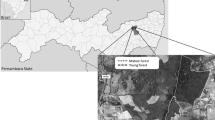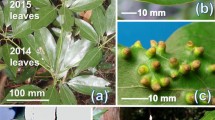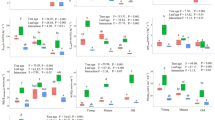Abstract
The seasonal changes in leaf emergence and leaf-fall in a Japanese alder stand of the fen in Kushiro Marsh were studied, and survival curves for the leaves were drawn. Leaves collected in litter traps were dried and weighed to study the seasonal changes, peaks in mid-August and late September to October suggested a bimodal annual curve. Study of the seasonal changes in the number of emerged and fallen leaves per shoot revealed a third peak about one month before the August peak, showing a trimodal annual curve. First and second leaves had a longevity of about 40 and 50–60 days, respectively. The longevity increased until the fifth leaf. With the sixth and following leaves, longevity decreased. Leaf size increased with leaf rank, with the first leaf being the smallest. The first leaf had only about 10% and the second leaf only 20% of the area of the fifth leaf. On this basis, the early to mid-July peak in number of fallen leaves was composed of first and second leaves which were smaller and short-lived. The early August and September/October peaks were high in both number and mass of fallen leaves. Compared to reports on Japanese alder of other mountainous districts in Hokkaido, the alder trees of Kushiro Marsh had about the same number of leaves per shoot, but had a season of leaf emergence which was about 6 weeks shorter. In addition, the longevity of the longest-lived fifth leaf was about 30–40 days shorter. The short life span of the leaves could be considered as an adaptive strategy of this species to environmental constraints of its habitat.
Similar content being viewed by others
References
Bazzaz F. A. 1979. The physiological ecology of plant succession. Ann. Rev. Ecol. Syst. 10: 351–371.
Bazzaz F. A. & Pickett S. T. A. 1980. Physiological ecology of tropical succession: A comparative review. Ann. Rev. Ecol. Syst. 11: 287–310.
Bloom A. J., ChapinIII F. S. & Mooney H. A. 1985. Resource limitation in plants-An economic analogy. Ann. Rev. Ecol. Syst. 16: 363–392.
Chabot B. F. & Hicks D. J. 1982. The ecology of leaf life spans. Ann. Rev. Ecol. Syst. 13: 229–259.
Gessel S. P. & Turner J. 1974. Litter production by red alder in western Washington. For. Sci. 20: 325–330.
Kanda F. & Hoshi H. 1982. Alnus japonica population around and in Kushiro Moor. J. Hokkaido Univ. Educ. 33: 19–31 (In Japanese).
Kikuzawa K. 1983. Leaf survival of woody plants in deciduous broad-leaved forest. 1. Tall trees. Can. J. Bot. 61: 2133–2139.
Kikuzawa K. 1991. A cost-benefit analysis of leaf habit and leaf longevity of trees and their geographical pattern. Am. Nat. 138: 1250–1263.
Kikuzawa K., Asai T. & Fukuchi M. 1984. Leaf-litter production in a plantation of Alnus inokumae. J. Ecol. 72: 993–999.
Koyama H. 1981. Photosynthetic rates in lowland rain forest trees of peninsular Malaysia. Jap. J. Ecol. 31: 361–369.
Moore P. 1980. The advantages of being evergreen. Nature 285: 535.
Murai S. 1964. Phytotaxonomical and geobotanical studies on genus Alnus in Japan (III). Taxonomy of whole world species and distribution of each sect. Rep. Exp. For. Res. Inst. 171: 1–107 (In Japanese).
Shaver G. R. 1981. Mineral nutrition and leaf longevity in an evergreen shrub, Ledum palustre ssp. decumbens. Oecologia (Berl) 49: 362–365.
Small E. 1972. Photosynthesic rates in relation to nitrogen recycling as an adaptation to nutrient deficiency in peat bog plants. Can. J. Bot. 50: 2227–2233.
Tachibana H. 1981. Marsh and swamp forest vegetation of Urabandai Heights in Fukushima Prefecture, Northeast Japan. J. Hokkaido Univ. Educ. 32: 33–48 (In Japanese).
Tanaka, M. 1977. Vegetation of the Kushiro Marsh, pp. 147–208. In: Kushiro Marsh, Kushiro City, Kushiro, Japan (In Japanese).
Tatewaki M. & Tsujii T. 1956. Botanical research in pastures of Hokkaido: centering on eastern Hokkaido. Hokkaido Development Bureau, Japan. 106 pp. (In Japanese).
Thomas W. A. 1976. Phosphorus conservation by evergreenness of mountain laurel. Oikos 27: 19–26.
Tsujii, T., Umeda, Y., Sakurada, J. & Shimizu, M. 1975. Vegetation and groundwater levels of peat lands: Basic ecological research of Kushiro Marsh. Hokkaido, Japan. 81 pp., (In Japanese).
Witkamp M. & van der Drift J. 1961. Breakdown of forest litter in relation to environmental factors. Plant Soil 15: 295–311.
Author information
Authors and Affiliations
Rights and permissions
About this article
Cite this article
Kanda, F. Survival curves and longevity of the leaves of Alnus japonica var. arguta in Kushiro Marsh. Vegetatio 124, 61–66 (1996). https://doi.org/10.1007/BF00045144
Received:
Accepted:
Issue Date:
DOI: https://doi.org/10.1007/BF00045144




